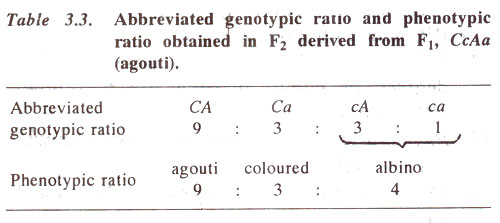Epistatic interaction means that one gene masks or changes the effect of another gene. In other words it does not allow the other gene to express itself fully. This is a counterpart of dominance. While dominance works at interallelic but intragenic level, epistasis works at intergenic level. Epistasis can be of the following types - (i) due to recessive allele :
a masks the effect of
B, (ii) due to a dominant allele :
A masks the effect of
B. In some cases, this may be in one direction only meaning that either
A masks the effect of
B or vice versa. In other cases, it can be in both the directions also, which means that both genes are mutually epistatic to each other.
Contrary to the above definition of epistasis, in population and quantitative genetics, epistasis refers to all non-allelic interactions including, complementary and duplicate interactions.
In mice, the wild body colour is known as
agouti, characterized by banding of individual hairs. The agouti colour is controlled by a gene, say
A, which is hypostatic to recessive allele c. The dominant allele
C in the absence of
A gives coloured mice. Moreover, in the presence of dominant allele C,
A gives rise to agouti. Therefore,
CCaa will be coloured and
ccAA will be albino. When coloured mice
(CCaa) are crossed with albino
(ccAA), agouti mice
(CcAd) appear in F
1The details of the genotypes and the phenotypes obtained in F
2 are given in Table 3.3.
As can be realized,
cc masks the effect of
AA in this example and is therefore epistatic. Consequently,
ccAa is albino. However,
ccaa is also albino, but not due to epistasis but due to the absence of both the dominant alleles.





